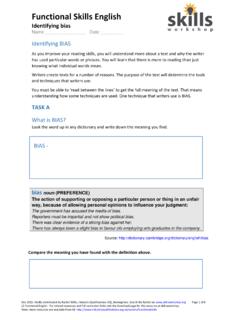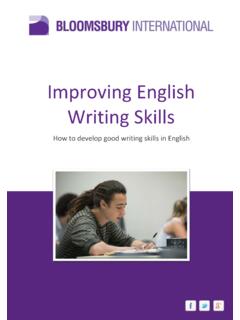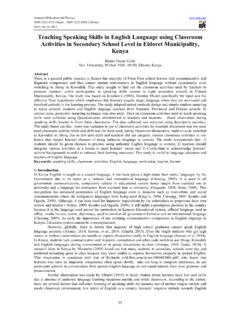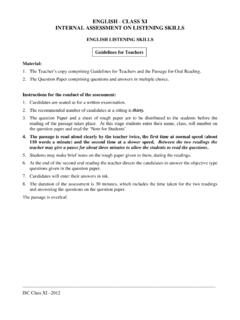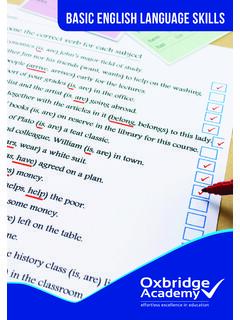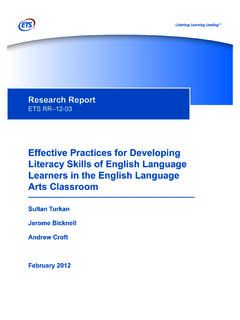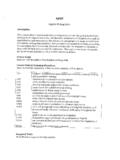Transcription of Subject content functional skills: English - GOV.UK
1 Subject content functional skills : English February 2018 2 Contents Purpose 4 functional skills English Entry Levels 1 to 3 5 Learning aims and outcomes at Entry Level 5 Subject content : Entry Level 1 6 Subject content : Entry Level 2 8 Subject content : Entry Level 3 10 functional skills English Level 1 and Level 2 12 Learning aims and outcomes at Levels 1 and 2 12 Subject content : Level 1 13 Subject content : Level 2 15 Glossary for use with this Subject content 17 Appendix 20 3 Introduction This document sets out the purpose, learning aims and outcomes, and Subject content for functional skills English at Entry Level, Level 1 and Level 2. functional skills English specifications must use the Subject content listed for each level and reflect the learning aims and outcomes set out at each level.
2 In interpreting the content , Awarding Organisations should note that the content at each level of qualification subsumes and builds upon the content at lower levels. Speaking, listening and communicating within functional skills English qualifications is non-written communication, normally conducted face-to-face, and can also include virtual communication methods such as telephone or spoken web-based technologies. The terms speaking, listening and communicating are intended to be interpreted in a broad, inclusive way and are not intended to create any unnecessary barriers to students with speech or hearing impairment. Reading within functional skills English qualifications is defined as the independent understanding of written language in specific contexts.
3 This can be demonstrated through the use of texts on screen or on paper. Writing within functional skills English qualifications is defined as the independent construction of written language to communicate in specific contexts. Text can be written on paper or electronically. Teaching methods should be based on the best available evidence for effective methods to support students to gain these skills . The structured teaching of phonics should be used to teach students at Entry Levels for Reading and Writing . 4 Purpose functional skills qualifications should provide reliable evidence of a student s achievements against demanding content that is relevant to the workplace. They need to provide assessment of students underpinning knowledge as well as their ability to apply this in different contexts.
4 They also need to provide a foundation for progression into employment or further technical education and develop skills for everyday life. In some contexts, functional skills qualifications will also play a part in the Government s accountability systems. A key aim for functional skills English specifications is that they should enable the student to develop confidence and fluency in, and a positive attitude towards, English . Students should be able to demonstrate their competence in English by using it in real-world situations as well as demonstrating a sound grasp of basic English knowledge and skills . Purpose of functional skills English for Entry Levels: a qualification to demonstrate the ability at an appropriate level to read, write, speak, listen and communicate in English , and to apply this knowledge and these skills in familiar situations.
5 Achievement of these qualifications can provide the basis for further study at Levels 1 and 2. Purpose of functional skills English for Level 1 and Level 2: a qualification for work, study and life. Achievement of the qualification demonstrates the ability at an appropriate level to read, write, speak, listen and communicate in English , and to apply these skills effectively to a range of purposes in the workplace and in other real life situations. 5 functional skills English Entry Levels 1 to 3 Learning aims and outcomes at Entry Level functional skills English qualifications at these levels indicate that students should be able to speak, listen, communicate, read and write with increasing clarity, accuracy and effectiveness at each level.
6 They should be able to: Listen, understand and respond to verbal communication in a range of familiar contexts; Acquire an understanding of everyday words and their uses and effects, and apply this understanding in different contexts; Read with accuracy straightforward texts encountered in everyday life and work, and develop confidence to read more widely; and Write straightforward texts and documents with clarity and effectiveness, and demonstrate a sound grasp of spelling, punctuation and grammar. Students should, with some direction and guidance, be able to apply these functional skills to informal and some formal contexts, in familiar situations. 6 Subject content : Entry Level 1 Speaking, Listening and Communicating Scope of study Text: this should include simple narratives, information and instructions, and short statements, explanations, discussions, questions and exchanges.
7 1. Say the names of the letters of the alphabet 2. Identify and extract the main information from short statements and explanations 3. Follow single-step instructions, asking for them to be repeated if necessary 4. Make requests and ask straightforward questions using appropriate terms and registers 5. Respond to questions about specific information 6. Make clear statements about basic information and communicate feelings and opinions on straightforward topics 7. Understand and participate in simple discussions or exchanges with another person about a straightforward topic Reading Scope of study Text: this should include short, simple texts that inform, describe and narrate. 8. Read correctly words designated for Entry Level 1 (see Appendix) 9.
8 Read simple sentences containing one clause 10. Understand a short piece of text on a simple Subject Writing Scope of study Text: this should include short simple texts such as messages and notes. Spelling, punctuation and grammar 11. Punctuate simple sentences with a capital letter and a full stop 12. Use a capital letter for the personal pronoun I and the first letter of proper nouns 13. Use lower-case letters when there is no reason to use capital letters 14. Write the letters of the alphabet in sequence and in both upper and lower case 15. Spell correctly words designated for Entry Level 1 (see Appendix) 7 Writing composition 16. Communicate information in words, phrases and simple sentences 8 Subject content : Entry Level 2 Speaking, Listening and Communicating Scope of study Text: this should include short narratives and explanations and instructions, discussions and straightforward information and instructions.
9 1. Identify and extract the main information and detail from short explanations 2. Make requests and ask clear questions appropriately in different contexts 3. Respond appropriately to straightforward questions 4. Follow the gist of discussions 5. Clearly express straightforward information and communicate feelings and opinions on a range of straightforward topics 6. Make appropriate contributions to simple group discussions with others about a straightforward topic Reading Scope of study Text: this should include short, straightforward texts that instruct, inform, describe and narrate. 7. Read correctly words designated for Entry Level 2 (see Appendix) 8. Understand the main points in texts 9. Understand organisational markers in short, straightforward texts 10.
10 Use effective strategies to find the meaning of words and check their spelling ( a simple dictionary, spell-checker) 11. Read and understand sentences with more than one clause 12. Use illustrations, images and captions to locate information Writing Scope of study Text: this should include short, straightforward texts such as letters, e-mails and simple narratives. Spelling, punctuation and grammar 13. Use basic punctuation correctly ( full stops, capital letters, question and exclamation marks) 14. Form regular plurals 9 15. Use the first and second letters to sequence words in alphabetical order 16. Spell correctly words designated for Entry Level 2 (see Appendix) Writing composition 17. Communicate information using words and phrases appropriate to audience and purpose 18.










